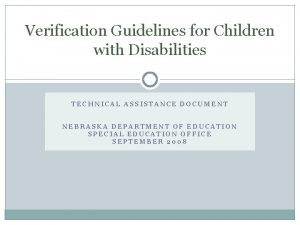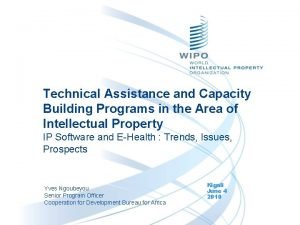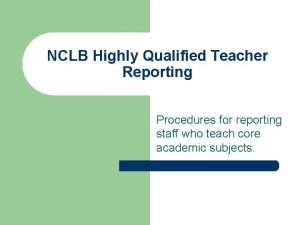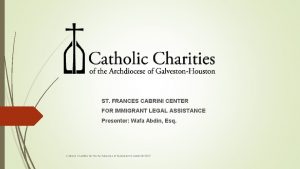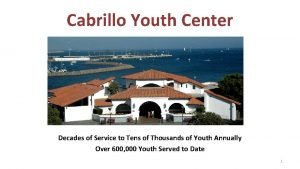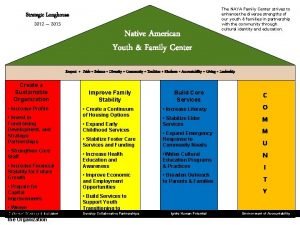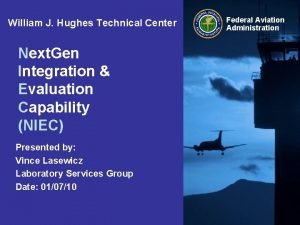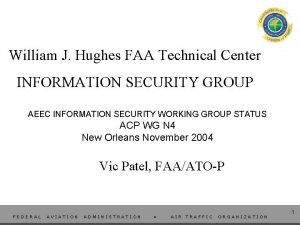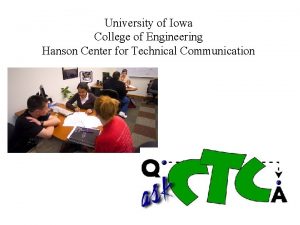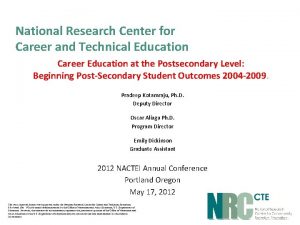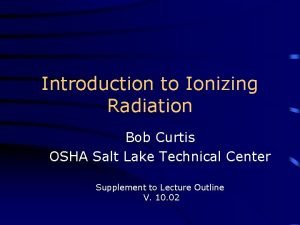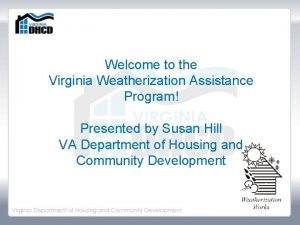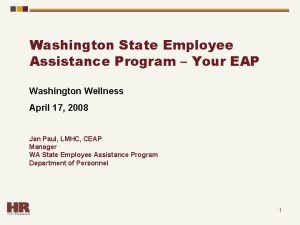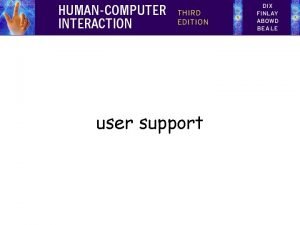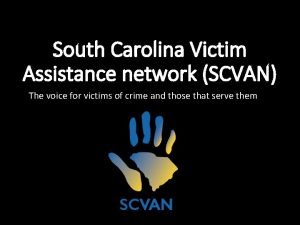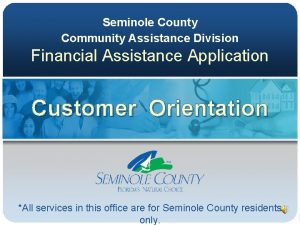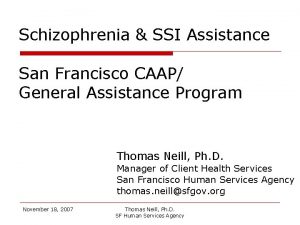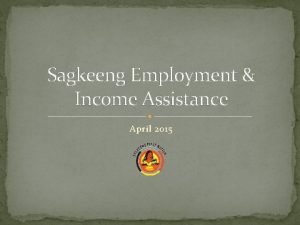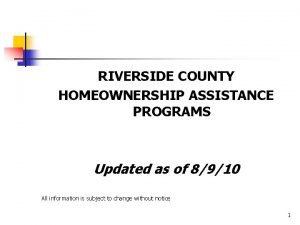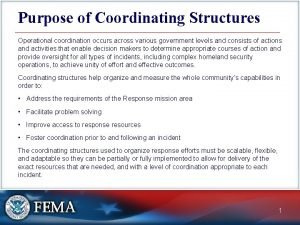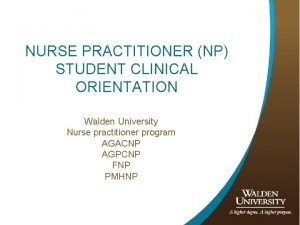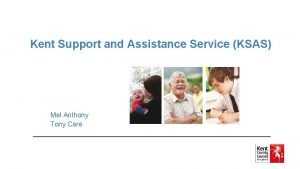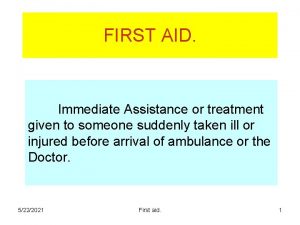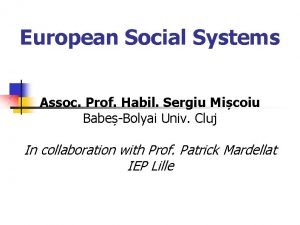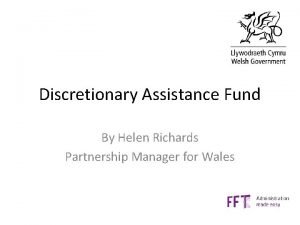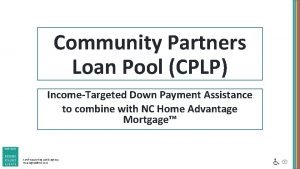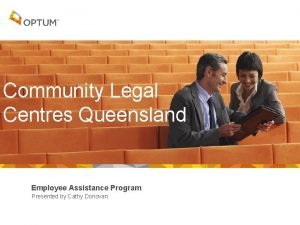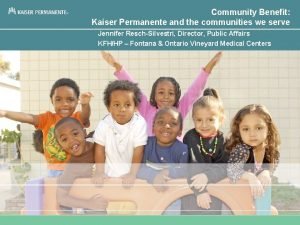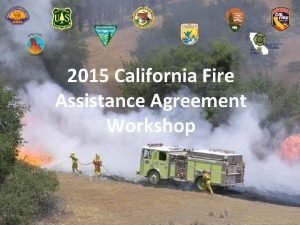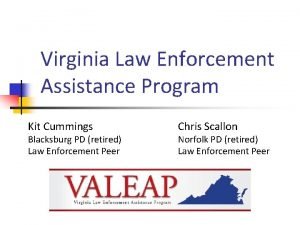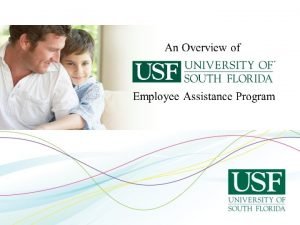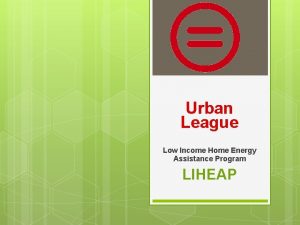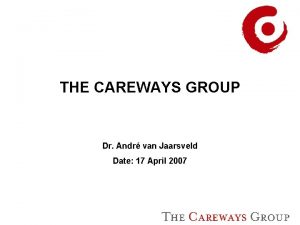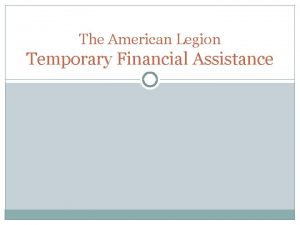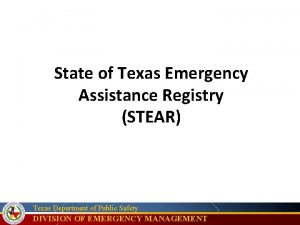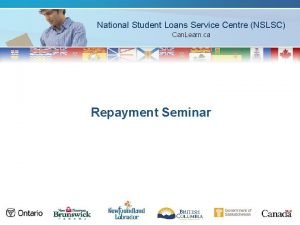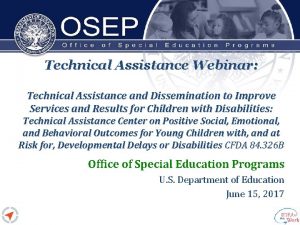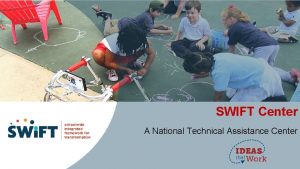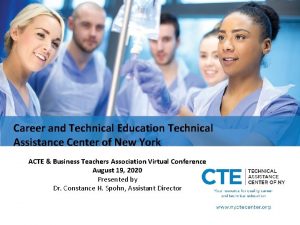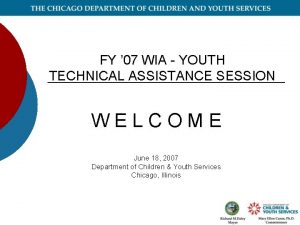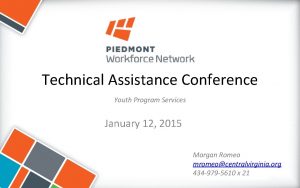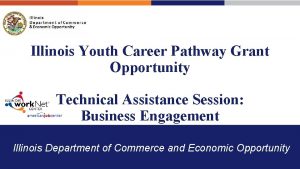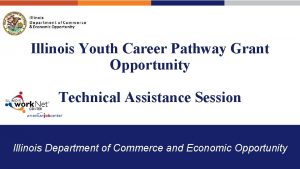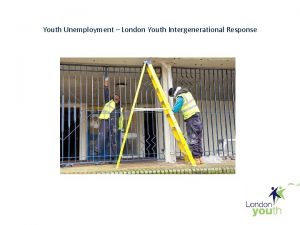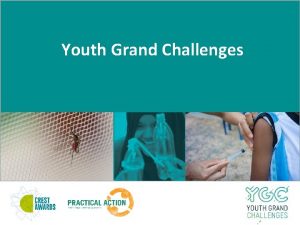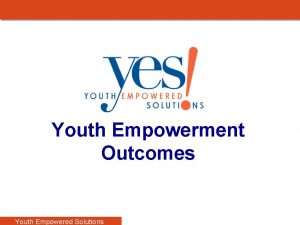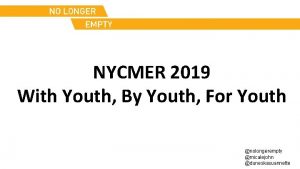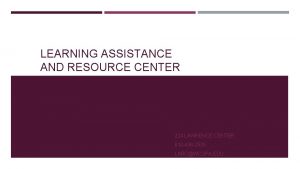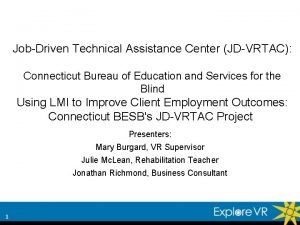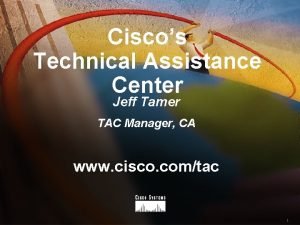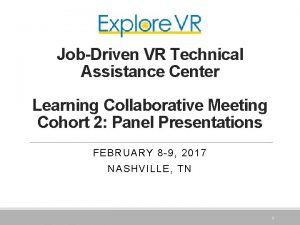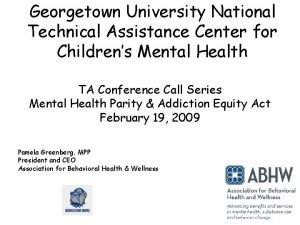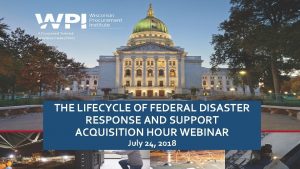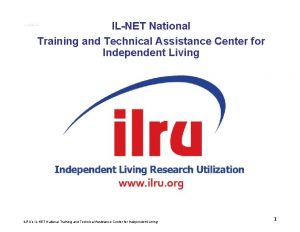Youth Technical Assistance Center Y Youth Technical Assistance












































- Slides: 44

Youth Technical Assistance Center (Y‐ Youth Technical Assistance Center (Y-TAC) Barriers v. Obstacles: Supporting Students with Complex Needs Kim Osmani, Y‐TAC and Michael Stoehr, NTACT 13 th OTI October 2018

Presenter s Kimberly Osmani, Technical Assistance Liaison, Vocational Rehabilitation Technical Assistance Center for Youth (Y‐ TAC) Michael Stoehr, Knowledge Development and Technical Assistance Specialist, National Technical Assistance Center on Transition (NTACT)

Overview of the Youth Focused Training and Technical Assistance (TA) Centers

Equipping Leaders to Better Prepare Children & Youth for College, Careers, & Citizenship The Institute for Educational Leadership (IEL) accomplished its work through three centers that address crucial pillars of success required for young people and their communities to succeed: 1. Connecting community with public education to support the learning and development of young people. 2. Building more effective pathways into the workforce to help all young people transition to adulthood. 3. Preparing generations of leaders to drive cooperative efforts at all levels. iel@iel. org www. iel. org 202‐ 822‐ 8405

The Y-TAC is a U. S. Department of Education’s Rehabilitation Services Administration (RSA)-funded Technical Assistance Center that is charged with providing State VR agencies and related rehabilitation and youth service professionals with technical assistance to help more effectively serve students and youth with disabilities, including disconnected youth who need to re-engage with education and/or work such as those involved in the juvenile justice system, the foster care system, and other traditionally underserved and/or isolated youth populations. VR Y-TAC 5

NTACT Team • PLUS cast of many content experts • Collaboratively funded by OSEP & RSA • January 1, 2015 ‐ December 31, 2019.

• Assist: NTACT’s Purpose – State Education and Vocational Rehabilitation Agencies, – Local Education Agencies, – VR Service Providers • To implement evidence-based and promising practices • Ensuring students with disabilities, including those with significant disabilities, • Graduate prepared for success in postsecondary education and employment.

� Objective s • Participants will learn evidence‐ /research‐based practices for serving students with complex needs as required under federal regulations. • Participants will discuss the barriers to transition outcomes and feel empowered to enhance implementation of transition services for students with complex needs. • Participants will be able to work with teams to provide transition experiences, incorporating person‐ centered planning, for students with complex needs.

Agenda • Who are students and youth with the most • • • complex needs? What are the barriers to successful transition outcomes for students with complex needs? What are the desired outcomes of the individual with complex needs and his/her family/caregiver/guardian? What are the legal requirements for supporting the transition of students and youth with the most complex needs? What is Secondary Transition Planning? What are current effective practices to support the transition of students and youth with the most complex needs? 9

Two Words Who do you think are students and youth with the most complex needs? VR – Perspective § Students with disabilities who may require: § Line of site supervision § Extra support for their physical and personal care § Communication support to fully participate § Individualized strategies for behavioral supports § Consideration of risk/safety issues § Contingencies for crisis management § Medication management supports

Who are students and youth with the most complex needs? Education – Perspective § Students with disabilities who require: § 1: 1 assistance for all activities of daily living § Very limited physical and/or mental stamina § Significant behavior issues § Limited communication response (1‐ 2 second eye gaze for yes/no answers) § Daily required supports from a medically trained professional § 1: 1 supports for social engagement activities

Students with Complex Needs Think about your students �Demonstrate diverse skills, strengths, limits, and support needs �Multiple system impairments that impact the student, family, community participation, and severity of associated health conditions �Two or more simultaneously occurring impairments �Supports are usually pervasive and extensive in order to achieve community living, employment, and self‐sufficiency.

The Big Picture: Guiding Questions Ask yourself: • What is it that we are actually doing to support this student/youth? • Is it meaningful? • Will it really help the student to achieve his/her post‐secondary goals and to enjoy a quality of life?

• What are critical outcomes for these students? • What are your students’ hopes and dreams for their future? • What are their parents’ hopes and dreams for their sons and daughters? • Think about the transition to a supported adulthood • Supported employment • Supported living • Supported membership in the community

Barriers • Communication challenges • One‐to‐one assistance necessary, staffing issues • Physical ability, limitations • Family needs/expectations • Lack of allocation of resources • Low expectations • Systems—“Not our job”, lack of interagency collaboration/data sharing • Lack of transportation options

Core Belief: All people and their families have the right to live, love, work, play and pursue their life aspirations in their community. 16

The Big Picture: Guiding Question s Ask yourself: • What is it that we are actually doing to support this student/youth? • Is it meaningful? • Will it really help the student to achieve his/her postsecondary goals and to enjoy a quality of life?

� � � � � • Should reflect high but realistic expectations • Should reflect a “forward movement” instead of a “dead‐end” approach • Can be “mixed” considering the Postsecondary student’s stamina, endurance and ability level Goals • Can incorporate external supports • May initially be less specific, increasing in detail as the student approaches graduation • May change from year to year, sometimes slightly, sometimes drastically

Legal • IDEA Consideration s • The Rehabilitation Act, as amended by WIOA • WIOA Pre‐Employment Transition Services • WIOA ‐ Section 511 • Employment First • Centers for Medicare and Medicaid Services (CMS) ‐ Final Rule for Home and Community‐Based Settings (HCBS) 19

Employment First A national movement and an alignment of systems that focus on the concept that: Employment in the general workforce is the first and preferred outcome in the provision of publicly funded services for all working age citizens with disabilities, regardless of level of disability. APSE Statement on Employment First 49 states have efforts focused on Employment First, out of which 33 have an official state policy, stating that employment in the community is the first and preferred service option for people with disabilities. The State Employment Leadership Network (SELN) ‐ http: //www. selnhub. org SELN – Employment First Resource List

In everyday language… We believe everyone that WANTS to work CAN work, if given the right supports in a setting that makes sense for the person. And…because Employment First isn’t Employment ONLY…. When people aren’t working, they can be supported to spend time in integrated community settings engaging in activities of their choice. 13

� Final Rule for HCBS Amends the Medicaid regulations to provide requirements regarding person‐centered plans of care, characteristics of settings that are home and community‐based as well as settings that may not be home and community‐based. These requirements reflect CMS’ intent that individuals receiving services and supports through Medicaid Waivers receive services in settings which are integrated in and support full access to the greater community. 22

Community Participatio n Supports The service should result in the person: • Increasing potential for employment; • Developing and sustaining a range of valued social roles and relationships; • Building natural supports; • Increasing independence; and • Experiencing meaningful community participation and inclusion. 23

Secondary Transition Planning How it all works together Johnson, C. E. (2004). Transition Services Flowchart. Center for Change in Transition Services, Seattle University. Seattle, WA. CC BY 4. 0.

Effective Transition Planning: • Interests: a measure of opinions, attitudes, and Identify preferences Interests and Preferences • Preferences: what the student values and likes • Postsecondary Education and Set Training Postsecondary • Employment Goals • Independent Living • Abilities: talents or acquired skills Further Assess Abilities, • Aptitudes: characteristics Aptitudes, and that inform us of a student’s Skills learning strengths or proficiency in a particular area

Preference Indicators • Child Preference Indicators • Personal Preference Indicators • Employment Support Indicators http: //www. ou. edu/education/centers‐and‐ partnerships/zarrow/transition‐assessment‐‐‐ severe‐disabilities/preference‐indicators


Assistive Technology Protocol for Transition Planning http: //www. ct. gov/ brs/lib/brs/pdfs/gui depostdocs/Assistiv e. Technology. Protoco l. For. Transition. Planni ng. pdf

Community. Based and Work-Based Learning Experiences • Start the conversations earlier about the possibility of employment in the community for a paycheck! • Set expectations high • Exposure Early: • • • Volunteering Job shadowing Service Learning/Internships General Work Experience Matched Work Experience Customized Job Experience • Consider: • • Conditions for success Potential contributions Tasks person can do How individual learns best Support strategies to ensure success Things to avoid Natural supports

Current Effective Practices to Support the Transition of Students and Youth with the Most Complex Needs 30

Students with Significant or Complex Support Needs Best Practices • Services driven by what the student needs. • Pre‐ETS required activities may build over time – not one and done. • Clear understanding and communication of student’s support needs. • Multi‐prong approach/collaboration/partnerships (internal & external) • Braided funding identified/outlined in interagency agreements, IEP meetings, or person‐centered planning meetings. • Strong family engagement builds hope and expectations for competitive, integrated employment. 31

Students with Significant or Complex Support Needs Best Practices • Connecting families with resources/experts (benefits planning). • Strong employer engagement tied to career pathways with multiple on and off ramps. • Innovative strategies (e. g. , video resumes showcase talent, reverse job fair) • Reallocate staff positions/hours (instructional aides or paras) from classroom to community 32

Person. Centered/Directed Planning Life Course Framework Daily Life and Employment (school/education, employment, volunteering, routines, life skills) Community Living (housing, living options, home adaptations and modifications, community access, transportation) Social and Spirituality (friends, relationships, leisure activities, personal networks, faith community)

Person. Centered/Directed Planning Life Course Framework Healthy Living (medical, behavioral, nutrition, wellness, affordable care) Safety and Security (emergencies, well‐being, legal rights & issues, guardianship options & alternatives ) Citizenship and Advocacy (valued roles, making choices, setting goals, responsibility, leadership, peer support)

Trajectory towards a Good Life Friends, family, enough money, job I like, home, faith, vacations, health, choice, freedom es m co w o t ory ut O ife L s d r a ct e j ra T Trajectory towards t h Vision of What I Don’t Want ings unwa nted www. supportstofamilies. o rg

Ben’s Life Trajectory Chores; boy scouts; school inclusion; circle of friends; riding bike; family vacations; church youth group; birthday parties; using debit card; football manager; homecoming king; volunteering fire station and Good Sam; High School diploma Special education negativity and low expectations; pressure to segregate; med side effects; scoliosis; seizures; physical barriers; 25 Continue to volunteer at fire station; find other volunteer ops; go to gym regularly; keep in touch with friends; increase time on own; go out with friends; spend daytime out of house; explore micro enterprise ideas; Sitting at home watching TV all day; relying only on paid supports; gain weight; eat unhealthy foods or drink too much Pepsi (caffeine); Spending time with family and friends; find a girlfriend; going on vacations; going to concerts; going to WWE; getting tattoos; having money to do things and buy what I want/need; job I like or start my own business; going to the fire station; being football manager/coach for Tigers; going to mass at St Ann’s; going to Nascar races; being healthy and fit; eating good food; drinking Pepsi; shooting hoops; going places and trying new things; staying very active during the day; Poor health, heart disease, diabetes; poverty; being lonely; having a guardian; living in an institution; being segregated or isolated; sitting at home too much; boredom; being treated differently;

Treating Barriers as Obstacle s 1. 2. 3. 4. Top 3 Barriers What is causing the barrier? What resource(s) will help overcome the obstacle? What is something you have done that has worked in the past? What is one action you can take now?

What next? 1. Identify interagency collaborations; 2. Identify who, in your state, is trained to do Person‐Centered Planning; 3. Select transition assessments to use with your students; 4. Think about the whole student and how to provide experiences; 5. Consider how you are receiving and communicating information about your students; and 6. Begin the transition process early— don’t just wait till junior or senior year.

• A Life for Me! Additiona l Resources • Accessing the Dream • Best practices for reevaluations • NTACT joint presentation containing sample goals, scenarios, and resources • Evidence‐based practices • Examples and non‐examples of students with the most significant disabilities • NCWD‐Youth: Communicating With and About People with Disabilities

Additiona l Resources • NCWD‐Youth: A Young Person’s Guide to Health Care Transition • NCWD‐Youth: Tapping into the Power of Families: How Families of Youth with Disabilities Can Assist in Job Search and Retention • NCWD‐Youth: Strategies for Youth Workforce Programs to Become Employer‐Friendly Intermediaries • Project 10 resources on employing youth with significant disabilities • Significant Disabilities Planning Assessment Form

QUESTIONS

Session Evaluation Please complete the evaluation of this session while it is fresh on your mind and leave in your seat or on table as you exit.

CONTACT Kimberly Osmani, Extension Associate, Y‐TAC kosmani@cornell. edu Michael Stoehr, Knowledge Development and Technical Assistance Specialist, NTACT mstoehr@uncc. edu For more information, contact us at VRY-TAC@iel. org http: //iel. org/vryouth‐tac

The Y‐TAC is a project of the Institute for Educational Leadership, supported by the U. S. Department of Education's Rehabilitation Services Administration. This document was developed by the Vocational Rehabilitation Youth Technical Assistance Center (Y‐TAC), funded by a grant/contract/cooperative agreement from the U. S. Department of Education, Rehabilitative Services Administration (Award # H 264 H 150006). The opinions expressed herein do not necessarily reflect the position or policy of the U. S. Department of Education. Nor does mention of trade names, commercial products, or organizations imply the endorsement by the U. S. Department of Education. Note: There are no copyright restrictions on this document. However, please credit the source and support of Federal funds when copying all or part of this document.
 Nde rule 51 technical assistance document
Nde rule 51 technical assistance document Sample technical assistance given to teachers
Sample technical assistance given to teachers Sample technical assistance given to teachers
Sample technical assistance given to teachers Technical assistance plan
Technical assistance plan Fda technical assistance network
Fda technical assistance network Travel assistance center
Travel assistance center Catholic charities cabrini center
Catholic charities cabrini center Cabrillo beach youth center
Cabrillo beach youth center Native american youth and family center
Native american youth and family center William j. hughes technical center
William j. hughes technical center William j. hughes technical center
William j. hughes technical center Hanson center for technical communication
Hanson center for technical communication National research center for career and technical education
National research center for career and technical education Wjh technical center
Wjh technical center Osha salt lake technical center
Osha salt lake technical center Virginia weatherization assistance program
Virginia weatherization assistance program Employee assistance program seattle
Employee assistance program seattle Types of user support
Types of user support Writ of assistance
Writ of assistance Nc victim assistance network
Nc victim assistance network Social assistance definition
Social assistance definition Seminole county community assistance
Seminole county community assistance General assistance sf
General assistance sf Sets sagkeeng
Sets sagkeeng First time buyer programs riverside county
First time buyer programs riverside county How do coordination structures help
How do coordination structures help Nehemiah down payment assistance
Nehemiah down payment assistance Walden np program
Walden np program Kent support and assistance service
Kent support and assistance service Chancery hisd
Chancery hisd Immediate assistance
Immediate assistance Social assistance definition
Social assistance definition Discretionary assistance fund
Discretionary assistance fund Community partners loan pool
Community partners loan pool Employee assistance program townsville
Employee assistance program townsville Www.kp.org/mfa/scal
Www.kp.org/mfa/scal Atap nevada
Atap nevada California fire assistance agreement
California fire assistance agreement Valeap
Valeap Usf employee assistance program
Usf employee assistance program Urban league energy assistance
Urban league energy assistance Careways employee assistance program
Careways employee assistance program American legion temporary financial assistance
American legion temporary financial assistance State of texas emergency assistance registry
State of texas emergency assistance registry Nslsc login online
Nslsc login online
